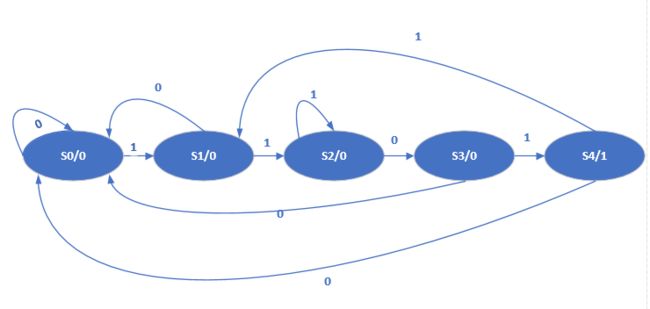23213131
设计一个序列检测器,检测序列1101,检测到输出1,否则输出0.
用状态机来实现序列检测器是非常合适的,下面先给出状态转移图,之后用Moore状态机来实现这个序列检测器:
(注:此处所画为无重叠检测,有重叠检测只需要改变最后一个状态即可,例如本例里,有重叠检测,如果S4状态下输入为1,则需要转向S2状态,其他不变。)
图1:Moore状态机状态转移图
先给出行为仿真示意图,示例代码后面贴出:
可见,每经历一个1101,输出就会是一个高脉冲,持续一个周期,也即输出是一个1.
该状态机的Verilog HDL描述为:
`timescale 1ns / 1ps
// Company:
// Engineer:
//
// Create Date: 2019/01/04 11:16:29
// Design Name:
// Module Name: seq_det_moore
// Project Name:
// Target Devices:
// Tool Versions:
// Description:
//
// Dependencies:
//
// Revision:
// Revision 0.01 - File Created
// Additional Comments:
module seq_det_moore(
input clk,
input reset,
input din,
output reg dout
);
//状态声明
localparam [2:0]
s0 = 3'b000,
s1 = 3'b001,
s2 = 3'b010,
s3 = 3'b011,
s4 = 3'b100;
reg [2:0] current_state,next_state;
always @(posedge clk, posedge reset)
begin
if(reset)
current_state <= s0;
else
current_state <= next_state;
end
always @ *
begin
case(current_state)
s0:
if(din == 1'b1) next_state = s1;
else next_state = s0;
s1:
if(din == 1'b1) next_state = s2;
else next_state = s0;
s2:
if(din == 1'b0) next_state = s3;
else next_state = s2;
s3:
if(din == 1'b1) next_state = s4;
else next_state = s0;
s4:
if(din == 1'b1) next_state = s1;
else next_state = s0;
default: next_state = s0;
endcase
end
always @*
begin
if(current_state == s4) dout = 1;
else dout = 0;
end
endmodule
RTL电路:
行为仿真代码:
`timescale 1ns / 1ps
// Company:
// Engineer:
//
// Create Date: 2019/01/04 15:24:59
// Design Name:
// Module Name: seq_det_moore_tb
// Project Name:
// Target Devices:
// Tool Versions:
// Description:
//
// Dependencies:
//
// Revision:
// Revision 0.01 - File Created
// Additional Comments:
//
module seq_det_moore_tb;
reg clk,reset;
reg din;
wire dout;
reg [20:0] din_mid;
integer i;
// Note: CLK must be defined as a reg when using this method
parameter PERIOD = 10;
always begin
clk = 1'b0;
#(PERIOD/2) clk = 1'b1;
#(PERIOD/2);
end
initial begin
reset = 1'b1;
din_mid = 21'b110111010110100101101;
# 20
reset = 1'b0;
din = 1'b0;
for(i = 0;i < 21;i = i + 1)
begin
#PERIOD
din = din_mid[i];
end
end
seq_det_moore uu1(.clk(clk),.reset(reset),.din(din),.dout(dout));
endmodule
编写这个简单的程序,并非毫无意义的,包括这个Testbench文件,自己动手编写往往能发现一些小的细节问题,你可能并不懂,例如,在测试文件(testbench)中,我使用到了for循环,出现了如下问题,首先我尝试使用了generate for循环语法,可是Vivado软件总是报错!!!
之后,我直接使用for循环,可是变量i的类型是什么呢?
reg,real都不对,最后使用了integer才成功,这说明了什么问题,当然是基础知识不牢固导致的,基础知识为什么不牢固,往往是因为练习的不多,语法书读的次数再多,往往很枯燥无味,问题还是需要在实践中去寻找,Verilog语言很类似C,这导致我们往往很不情愿去仔仔细细地去学,稍微关注些可综合的语法,之后拿来就用。至今我仍不愿意去细看所有的语法。解决的办法就是实践。
第二个问题就是在测试文件中,定义了参数parameter PERIOD,可是后面为什么不能对此参数进行运算呢?例如我想延时2 * PERIOD,Vivado仍然报错。让我郁闷!
上述这些问题都出现在我的初次表写测试文件的代码中,这里给出错误的初稿代码:(供大家发现问题)
`timescale 1ns / 1ps
// Company:
// Engineer:
//
// Create Date: 2019/01/04 15:24:59
// Design Name:
// Module Name: seq_det_moore_tb
// Project Name:
// Target Devices:
// Tool Versions:
// Description:
//
// Dependencies:
//
// Revision:
// Revision 0.01 - File Created
// Additional Comments:
//
module seq_det_moore_tb;
reg clk,reset;
reg din;
wire dout;
reg [20:0] din_mid;
// Note: CLK must be defined as a reg when using this method
parameter PERIOD = 10;
always begin
clk = 1'b0;
#(PERIOD/2) clk = 1'b1;
#(PERIOD/2);
end
initial begin
reset = 1'b1;
din_mid = 21'b110111010110100101101;
#2*PERIOD
reset = 1'b0;
generate
genvar i;
for(i = 0;i < 21;i ++)
begin
#PERIOD
din = din_mid[i];
end
endgenerate
end
seq_det_moore uu1(.clk(clk),.reset(reset),.din(din),.dout(dout));
endmodule


